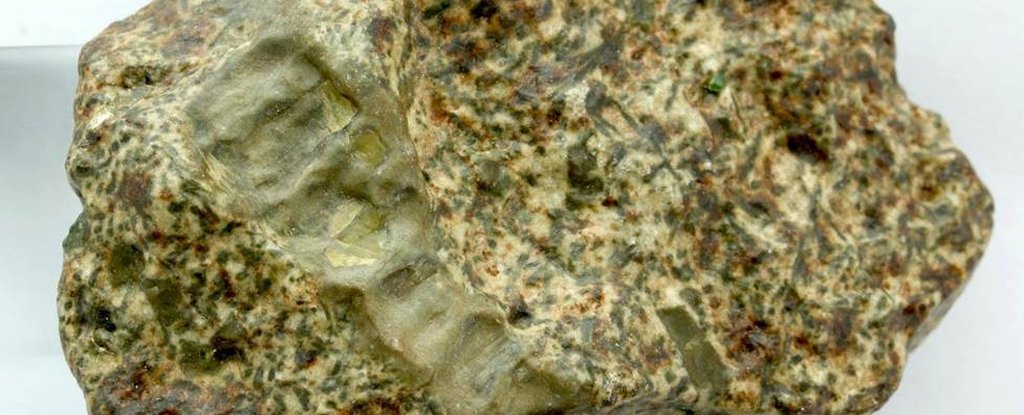Key Takeaways:
- A meteorite discovered in Algeria is older than Earth and formed through volcanic activity.
- The meteorite suggests it may have once been part of a protoplanet’s crust.
- The meteorite is a rare type of volcanic rock called andesite, which is not commonly found in meteorites.
- The andesite composition suggests the formation of protoplanets with andesite crusts may have been common.
- The meteorite’s age suggests its protoplanetary siblings may have contributed to the formation of Earth.
A piece of meteorite discovered in Algeria’s desert may be the remains of a newborn planet that never made it.
A detailed study of the composition and age of the rock reveals that Erg Chech 002, a meteorite, is not only older than Earth but also formed through volcanic activity, indicating that it may have once been a component of a protoplanet’s crust.
Because of this, it offers a unique chance to investigate the early phases of planet formation and discover more about the conditions that existed in the early Solar System, when the planets that we know and love today were still forming.

The pieces of rock known as EC 002, which weigh a total of 32 kg (70 pounds) when combined, were discovered in the Erg Chech sand sea in southwest Algeria. It was quickly determined to be unusual because, in contrast to most recovered meteorites, which are composed of chondritic material (dust and rock sticking together), this meteorite’s texture was igneous with inclusions of pyroxene crystals.
As a result, it was identified as an achondrite, a meteorite composed of material that appears to have originated from volcanic eruptions, and it was thought to have originated on a protoplanet, a body that had undergone internal melting to separate its crust from its core.
Just 3,179 meteorites out of the tens of thousands that have been identified as meteorites are achondrites, according to the Meteoritical Bulletin Database.
The majority of these achondrites are basaltic in composition and originate from one of two parent bodies. Thus, they are not able to provide us with much information regarding the variety of protoplanets in the early Solar System.
However, EC 002, according to a group of researchers headed by geochemist Jean-Alix Barrat of the University of Western Brittany in France, is not basaltic; rather, it is an andesite type of volcanic rock.
This makes EC 002 incredibly rare among all the meteorites we have discovered to date, even among achondrites, and provides a fresh perspective on planet formation.
The rock is old, based on the team’s analysis. The radioactive decay of isotopes of aluminium and magnesium suggest that these two minerals crystallised around 4.565 billion years ago, in a parent body that accreted 4.566 billion years ago. The age of the Earth is 4.54 billion years, for context.
“This meteorite is the oldest magmatic rock analysed to date and sheds light on the formation of the primordial crusts that covered the oldest protoplanets,” the authors of the paper said.
Andesite is mainly made up of silicates that are rich in sodium, unlike basalt, which is formed by the fast cooling of lava that is rich in iron and magnesium. Subduction zones, or places where two tectonic plates collide, are where andesite forms on Earth.
Although it’s found rarely in meteorites, the recent discovery of andesite in meteorites found in Antarctica and Mauritania prompted scientists to investigate how it might occur. Experimental evidence suggests that it can form from the melting of chondritic material.
Because chondritic bodies are so common in the Solar System, it’s possible that the formation of protoplanets with andesite crusts was also common. Nevertheless, nothing in the Solar System matched the meteorite’s spectral properties when the team compared EC 002’s spectral characteristics—that is, how it interacts with light—with the spectral characteristics of asteroids.
Andesitic crustal remains are not only rare in the meteorite record; they are also rare in the asteroid belt. Which raises the question: if the formation process was so simple and common, then where the heck did all the differentiated protoplanets get to?
The same place most of the material in the Solar System ended up, probably: they either got pulverised, or incorporated into larger rocky bodies; or, perhaps, a combination of both.
Given the age of EC 002, it is possible that its protoplanetary siblings contributed to the formation of Earth by forming a knot of denser material in the dust cloud surrounding the young Sun.
Although we have a pretty decent grip on how baby planets are born, growing over millions of years as clumps of rocks and dust stick together, the specifics of the process are a little more mysterious.
We have a fantastic opportunity to refine our understanding of how our home system arose from the dust with EC 002.
The study’s findings have been released in PNAS.


